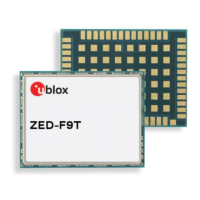ZED-F9T-Integration Manual
4.8.3 RF front-end circuit options
It is mandatory that the RF input is fed by an active antenna meeting the requirements for
the ZED-F9T.
The first stages of the signal processing chain are crucial to the overall receiver performance.
When an RF input connector is employed this can provide a conduction path for harmful or
destructive electrical signals. If this is a likely factor the RF input should be protected accordingly.
Additional points on the RF input
• What is the expected quality of the signal source (antenna)?
• What is the external active antenna signal power?
• What is the bandwidth and filtering of the external active antenna?
• Does the external antenna and filtering components meet the group delay variation
requirements? This is critical for RTK.
Are destructive RF power levels expected to reach the RF-input? Is interference from wireless
transmitters expected?
• What are the characteristics of these signals (duty cycle, frequency range, power range,
spectral purity)?
• What is the expected GNSS performance under interference conditions?
Is there a risk of RF-input exposure to excessive ESD stress?
• In the field: Is the antenna connector accessible by the user?
• PCB / system assembly: Is there risk that statically charged parts (e.g. patch antennas) may be
discharged through the RF-input?
The following subsections provide several options addressing the various questions above:
In some applications, such as GSM transceivers, interference signals may exceed the
maximum power rating of the RF_IN_1 input. To avoid device destruction use of external
input protection is mandatory.
During assembly of end-user devices which contain passive patch antennas, an ESD
discharge may occur during production when pre-charged antennas are soldered to the
GNSS receiver board. In such cases, use of external protection in front of RF_IN_1 is
mandatory to avoid device destruction.
ESD discharge cannot be avoided during assembly and / or field use. Note also that SAW filters are
susceptible to ESD damage. To provide additional robustness an ESD protection diode can be placed
at RF_IN_1 to GND.
4.8.4 Antenna/ RF input
Check RF input requirements and schematic:
• An OEM active antenna module that meets our requirements should be used if there is a need
to integrate the antenna.
• The total maximum noise figure including external LNA (or the LNA in the active antenna)
should be around 2 dB.
• Ensure active antenna gain is ideally between 30 - 40 dB gain.
• Make sure the antenna is not placed close to noisy parts of the circuitry and not facing noisy
parts. (e.g. micro-controller or display).
• Signal levels above 40 C/No average are required for optimal RTK performance.
• Ensure antenna supports both L1 and L2 bands.
• Ensure antenna element gain is between 2 - 3 dBic typical for L1 and L2 bands.
UBX-19005590 - R01
4 Design Page 70 of 80
Advance Information

